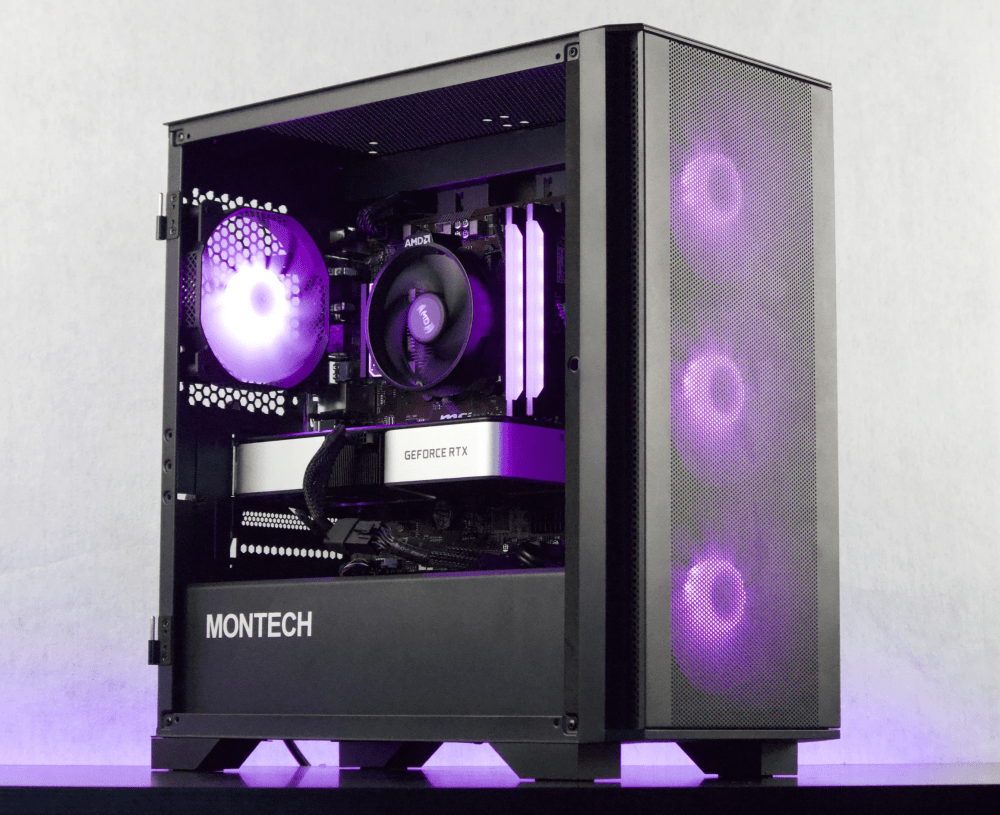Welcome to our blog post on how to hide GPU cables! If you're a PC enthusiast or gamer, you know how important it is to have a clean and organized workstation. One aspect of achieving that clean look is properly managing and hiding the cables from your GPU.
In this blog post, we will guide you through the process of hiding GPU cables, starting with the basics of why it's important to do so. We will then move on to preparing your workstation for cable management, including the necessary supplies and cleaning and organizing tips.
Next, we will explore different methods to hide GPU cables effectively. From using cable sleeves and ties to routing cables behind the motherboard tray and installing a PSU shroud, we will provide step-by-step instructions to help you achieve a clean and clutter-free look.
But the work doesn't stop there. We will also discuss the importance of regular cable management to maintain the clean look you've achieved. We'll share tips on checking for loose or misplaced cables, maintaining the cleanliness of your workstation, and regularly re-evaluating your cable layout.
So, whether you're a seasoned PC builder or a beginner looking to improve your cable management skills, this blog post will provide you with the knowledge and tips you need to hide GPU cables like a pro. Let's get started!
Understanding the Basics: Why Hide GPU Cables?
When it comes to building a clean and aesthetically pleasing PC setup, hiding GPU cables plays a crucial role. Let's dive into the basics of why it's important to hide GPU cables and the benefits it brings:
Enhances Visual Appeal
One of the primary reasons to hide GPU cables is to improve the overall visual appeal of your workstation. Unruly cables hanging loose and cluttering your setup can be an eyesore. By hiding the GPU cables, you can achieve a clean and organized look that enhances the overall aesthetics of your PC.
Improves Airflow and Cooling
Proper cable management not only looks good but also has practical benefits. When cables are neatly routed and hidden, they don't obstruct the airflow within your PC case. This allows for better ventilation and cooling, which is crucial for maintaining optimal temperatures for your components, especially the GPU.
Reduces Interference and Cable Damage
When cables are left exposed and tangled, there is a higher risk of interference and damage. Cables can get tangled with each other or other components, leading to potential performance issues or even hardware damage. By hiding the GPU cables, you minimize the chances of cables coming in contact with moving parts or getting snagged during maintenance or upgrades.
Facilitates Easy Troubleshooting and Upgrades
Having neatly hidden GPU cables makes troubleshooting and upgrading your PC much easier. When cables are organized and labeled, it becomes simpler to identify and trace specific cables when making adjustments or diagnosing issues. This saves time and reduces the chances of making mistakes during maintenance or upgrades.
Professional and Neat Presentation
If you use your PC for professional purposes, such as streaming or content creation, a tidy cable management setup presents a more professional image. Whether you have a home office or a dedicated streaming setup, hiding GPU cables adds a touch of professionalism and helps create a more focused and distraction-free environment.
Now that we understand the importance of hiding GPU cables, let's move on to the next section, where we'll discuss how to prepare your workstation for effective cable management.
Preparing Your Workstation for Cable Management
Before you dive into hiding GPU cables, it's essential to prepare your workstation properly. Adequate preparation ensures a smoother and more effective cable management process. In this section, we will discuss why proper preparation is necessary, the supplies you'll need, and how to clean and organize your workstation.
Why Proper Preparation is Necessary
Preparing your workstation before tackling cable management is crucial for several reasons:
-
Accessibility: Clearing your workstation of any obstacles or unnecessary components makes it easier to access and work with the cables, ensuring a more efficient process.
-
Safety: By removing any potential hazards or clutter, you minimize the risk of accidents or damage to your components during the cable management process.
-
Visualization: A clean and organized workspace allows you to visualize the cable routing options and plan your cable management strategy more effectively.
Gathering Necessary Supplies
To prepare for cable management, you'll need a few essential supplies. Here are some items you should consider having on hand:
-
Cable ties or Velcro straps: These are essential for securing and bundling cables together.
-
Cable management clips: These clips help route and hold cables in place along the edges of your case or other designated areas.
-
Cable sleeves: If you want to give your cables a more streamlined and uniform look, cable sleeves are a great option.
-
Cable combs: These handy tools help straighten and align individual cables, giving them a cleaner and more organized appearance.
-
Screwdriver or toolset: Depending on your case and components, you may need a screwdriver or other tools to access and work with the cables effectively.
Cleaning and Organizing Your Workstation
Before you begin managing your GPU cables, take the time to clean and organize your workstation. This will create a more pleasant and efficient environment for the cable management process. Here are some steps to follow:
-
Clear your workspace: Remove any unnecessary items, such as papers, clutter, or non-essential peripherals, from your desk or workspace.
-
Dust and clean your PC case: Use compressed air or a soft cloth to remove any dust or debris from your PC case. This helps maintain optimal airflow and prevents dust from accumulating on your cables.
-
Organize your components: If you have any additional components or peripherals, such as external hard drives or USB hubs, consider organizing and securing them to minimize cable clutter.
-
Plan cable routing: Take a moment to visualize how you want your cables to be routed. Consider the available cable management options in your case and plan the most efficient and aesthetically pleasing layout.
By properly preparing your workstation, gathering the necessary supplies, and cleaning and organizing your space, you'll be ready to tackle the cable management process with ease and efficiency. In the next section, we will explore different methods to hide GPU cables effectively.
Methods to Hide GPU Cables
Once your workstation is prepared, it's time to explore various methods to effectively hide GPU cables. In this section, we will discuss different techniques and strategies that you can employ to achieve a clean and organized cable management setup.
Using Cable Sleeves
Cable sleeves are an excellent option for hiding GPU cables while also providing a uniform and streamlined look. Here's how you can use cable sleeves:
-
Measure and cut: Measure the length of the cables you want to sleeve and cut the sleeves accordingly. Make sure to leave some extra length for flexibility.
-
Insert the cables: Slide the cables through the sleeves, ensuring that each cable is fully covered by the sleeve.
-
Secure the ends: Use heat shrink tubing or cable ties to secure the ends of the sleeves, preventing them from slipping off the cables.
-
Route the sleeved cables: Once the cables are sleeved, carefully route them along designated cable management paths, such as behind the motherboard tray or through cable routing holes in your case.
Utilizing Cable Ties
Cable ties are inexpensive and effective tools for managing and hiding GPU cables. Here's how you can use cable ties:
-
Bundle cables together: Gather the cables that you want to manage and bundle them together using cable ties. Make sure not to overtighten the ties to avoid damaging the cables.
-
Secure the cables: Attach the bundled cables to designated cable management points in your case using adhesive-backed cable tie mounts or other available fixtures.
-
Route the cables: Once the cables are secured, route them neatly along the designated cable management paths, ensuring they are not obstructing airflow or interfering with other components.
Routing Cables Behind the Motherboard Tray
Routing cables behind the motherboard tray is an effective way to hide GPU cables and achieve a clean look. Here's how you can do it:
-
Identify cable routing holes: Most modern PC cases have designated holes or channels behind the motherboard tray for cable management. Identify these openings and plan your cable routing accordingly.
-
Group and route cables: Group the GPU cables together and carefully route them through the available cable routing holes, ensuring they are not excessively bent or pinched.
-
Secure cables: Use cable ties or Velcro straps to secure the cables along their route, keeping them organized and preventing them from sagging or interfering with other components.
Installing a PSU Shroud
If your PC case has a PSU shroud, you can take advantage of it to hide GPU cables effectively. Here's how you can use a PSU shroud:
-
Remove the side panel: Open your PC case by removing the side panel that provides access to the interior.
-
Install the PSU shroud: If your case has a removable or modular PSU shroud, install it according to the manufacturer's instructions. This shroud helps conceal the PSU and cables, creating a cleaner look.
-
Route the cables: Once the PSU shroud is in place, route the GPU cables behind the shroud, using the available cable management channels or holes to guide the cables.
-
Secure and manage the cables: Use cable ties or Velcro straps to secure and manage the cables along their route, ensuring they stay hidden and organized.
Custom Cable Lengths
For those seeking the cleanest and most customized cable management solution, custom cable lengths are an option. This involves purchasing or making cables that are precisely measured to the required lengths for your specific setup. Custom cable lengths minimize excess cable clutter and allow for a clean and tailored appearance.
By utilizing cable sleeves, cable ties, routing cables behind the motherboard tray, installing a PSU shroud, or opting for custom cable lengths, you can effectively hide GPU cables and achieve a clean and organized cable management setup. In the next section, we will discuss the importance of regular cable management to maintain the clean look you've achieved.
Maintaining a Clean Look: Regular Cable Management
Achieving a clean and organized cable management setup is not a one-time task. To maintain the clean look you've achieved, regular cable management is essential. In this section, we will discuss the importance of regular cable management and provide tips to help you maintain a tidy workstation.
Regularly Check for Loose or Misplaced Cables
Over time, cables can become loose or misplaced, especially if you frequently move or modify your setup. It's essential to regularly inspect your workstation and check for any loose or dangling cables. Here are some tips to help you with regular cable maintenance:
-
Visual inspection: Take a few moments every few weeks to visually inspect your cables. Look for any cables that have come loose from their designated routes or have become tangled with other cables.
-
Re-secure loose cables: If you find any loose cables, use cable ties or Velcro straps to secure them back in place. Make sure the cables are neatly routed and not obstructing airflow or interfering with other components.
-
Re-evaluate cable routing: If you notice that certain cables keep coming loose or becoming tangled, consider re-evaluating their routing. Look for alternative cable management paths or use additional cable management accessories, such as cable clips or adhesive-backed mounts, to keep the cables in place.
Maintain Cleanliness of Your Workstation
Regularly cleaning your workstation goes hand in hand with maintaining a clean cable management setup. Here are some tips for keeping your workstation clean:
-
Dust regularly: Dust can accumulate on cables and components, affecting airflow and the overall appearance of your setup. Use compressed air or a soft cloth to regularly remove dust from your PC case and cables.
-
Vacuum or wipe down your desk: Dust and debris can also accumulate on your desk or workspace. Regularly vacuum or wipe down your desk to keep it clean and free from any potential cable hazards.
-
Cable organization accessories: Consider using cable management accessories such as cable clips, cable raceways, or cable sleeves to keep your cables organized and prevent them from tangling or becoming a cluttered mess.
Regular Re-evaluation of Cable Layout
As your setup evolves or you add new components, it's essential to periodically re-evaluate your cable layout. Here's why:
-
Upgrades and modifications: When upgrading or adding new components, you may need to reroute or adjust your cables to accommodate the changes. Take the opportunity to re-evaluate your cable management and ensure everything is organized and hidden properly.
-
Optimal airflow: Over time, you may notice changes in your system's airflow due to dust accumulation or component upgrades. Re-evaluating your cable layout allows you to optimize airflow and ensure that cables are not obstructing ventilation.
-
Aesthetics: As your tastes and preferences change, you may want to update the appearance of your setup. Regularly reassessing your cable layout gives you the opportunity to make adjustments and improve the overall aesthetics of your workstation.
By regularly checking for loose cables, maintaining cleanliness, and periodically re-evaluating your cable layout, you can ensure that your cable management remains clean and organized over the long term. This not only enhances the visual appeal of your setup but also helps maintain optimal airflow and reduces the risk of cable-related issues.
Congratulations! You now have the knowledge and tips to effectively hide GPU cables and maintain a clean and organized cable management setup. Implement these strategies, and enjoy a clutter-free and visually appealing workstation.
Ready to level up your game? Check out Jawa for the best deals on PC gaming hardware





